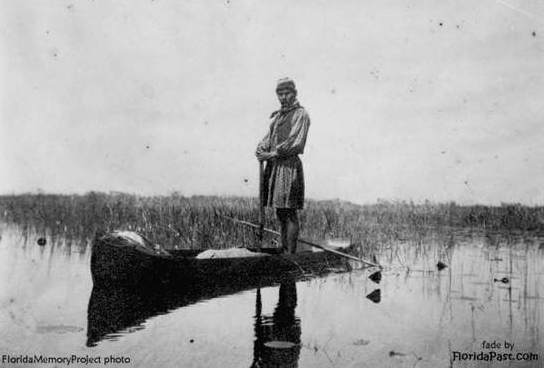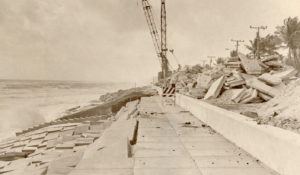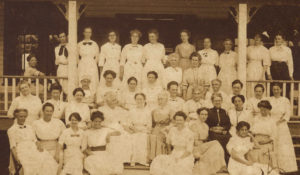The area known as “Lake Ida” was once twice as big as it is now and part of the Everglades – a natural region of tropical wetlands in the Southern portion of Florida. William S. Linton, one of the founders of Delray Beach, named Lake Ida after his wife, Ida. It was accessible only by taking a boat through saw grass and alligators and snakes were often seen swimming along the shores. Most homes were raised a foot or two above ground for ventilation and protection from the constant thick swarm of mosquitos. The lake featured bottomless areas and reached almost to the south part of Atlantic Avenue and up to the back doors of early settler homes on Swinton Avenue.
Lake Ida receded to its current size after the Everglades drainingwas done around 1917 by the Lake Worth Draining System. Receding wetlands was typical in Florida alongside population growth and development.
Lake Ida and the rest of Delray Beach during the early days was a true wilderness. We know that Seminole Indians camped here before and during the pioneer days. In the early 1900’s, water was so abundant most settlers began growing Pineapples. There was a natural flow of water from the south end of Lake Ida that washed thorough the west side of town (then called Hanna Town) along where SW 5th Avenue runs today. This flow was called “Frog Alley” because the frogs were so dense. Today, Frog Alley is being considered for historic designation and is mostly single-family homes, some of which are more than 50 years old, running south of Atlantic Avenue between Southwest Sixth and Fourth avenues.
The first homes in Lake Ida, built during the 1920s, were frame structures built of local Dade County pine with siding and interiors of local cypress. The Delray Beach area actually had the largest forest of Dade County Pine in the state, according to the Florida Department of Agriculture. Cypress grew abundantly in the swampy area around Lake Ida. Later homes were built of stone, tile and stucco. Samuel Ogren, the first resident architect in Delray Beach, designed more than 250 houses and buildings here between 1924 and 1950, many of them on Swinton Avenue. Ogren was influenced by famed architect Addison Mizner, who introduced the Mediterranean Revival style to South Florida in the 1920s. Samuel Ogren Jr. designed the home he built on Lake Drive in 1953. His widow still owns the home. By the 1940s and ’50s the Lake Ida neighborhood spread westward from Swinton Avenue. Local architects Kenneth Jacobson, Dick Hannah and Roy Simon designed many of the homes still standing in the area.
A legendary resident of Lake Ida, Warren G. Grimes (1898–1975) was a major influencer and philanthropist in Delray Beach beginning in the 1940’s. He was born in Montgomery County Ohio, just a few miles from where the Wright Brothers lived and worked. Mr. Grimes was a prominent entrepreneur, inventor and is known as the “Father of the Aircraft Lighting Industry,” featured in the National Aviation Hall of Fame. He and his wife Charlotte came to Delray Beach in the 1940’s and stayed at the Colony Hotel before he built a beach house in 1945. In 1959 Grimes purchased a large property on what was then the western fringes of Delray Beach, and built a research and development facility. During the 1960’s he developed aircraft appliances, including coffee makers, ovens and other galley appliances still used on commercial jets today. The building still stands on the west side of Lake Ida, north of the Lake Ida Park. In 1961 he also built a Japanese-inspired home on a peninsula in Lake Ida. This unique, octagonal structure, with pagoda-style roofs and curving walls stands at 3850 South Lake Drive.
Mr. Grimes owned the Delray Beach Golf Club in the 1950’s and 1960’s and for many years he sponsored Fourth of July fireworks on Lake Ida. He donated land for Bethesda Memorial Hospital, Lakeview Baptist Church, Unity Church and School and the Delray Beach Police Benevolent Association.
One of the hidden gems of the Lake Ida neighborhood is the Delray Beach Playhouse. Did you know the Delray Beach Playhouse is one the nation’s oldest and most successful community theaters? In 1947, the vision of live theatre in Delray Beach became a reality thanks to the efforts of Robert Blake, Tommy Thames and J. Stuart Warrington. They, along with friends, formed the Little Theatre of Delray. Five years later, the name was changed to The Delray Beach Playhouse.
The first plays were presented downtown in the Parish Hallof St. Paul’s Episcopal Church on Swinton Avenue. The site was moved to the City’s main firehouse and performances were often interrupted by emergency calls. Audiences sat patiently through the sirens for 10 years until 1957, when a new Playhouse was built on the shores of Lake Ida. Additions were added in 1977 and renovations in 1994 included an expanded lobby, restroom and wheelchair accessibility.
Several notable residents lived in the Lake Ida area. Edna St. Vincent Millay, American lyrical poet, winner of the Pulitzer Prize for Poetry, lived in a home on North Swinton during two winters. Her address is unknown and the quest for this information has been a mission of many local history buffs.
W.J. Pat Enright was a famous cartoonist for the Democratic Party as well as a cartoonist for the The New York World and The New York American. He first visited Delray Beach in the 1920’s and moved permanently in 1934. He became an editorial cartoonist for the Miami Herald and the Palm Beach Post. An environmentalist with a special affinity for the Florida alligator, Enright use to take a bus to Miami to work. One of his most popular creations was “Al Alligator,” the main character in a series of children’s books written and illustrated by Enright. He lived at 2004 North Swinton Avenue and at 89 and 109 NW 12 Street during the 1950’s and 60’s. He was part of Delray Beach’s “Artist Colony” and is remembered as a charming and thoughtful man by his neighbors on NW 12th Street.
Where Trinity Lutheran is now on the corner of North Swinton and lake Ida Road was once the home and writing studio of Nina Wilcox Putnam. She called her property, “Galloping Tiger Ranch.” It was one of the earliest homes in Lake Ida and was the “scene of many gay parties among the younger set,” according to a 1926 item in the Palm Beach Daily News. Putnam was a prolific writer of romances, westerns, musical comedies and horror. The 1932 Boris Karloff film, The Mummy, was based on her stories. Putnam was known as one of the highest paid writers in North America and contributed $100 towards the founding of the Delray Beach Public Library. It is also said that she had the first swimming pool in Delray Beach.
Lake Ida continues to be one of Delray Beach’s treasured neighborhoods, popular for a quiet, family life and recreation such as boating, skiing and fishing.




